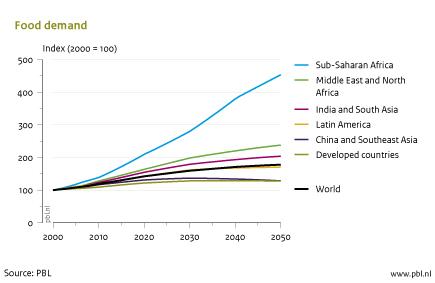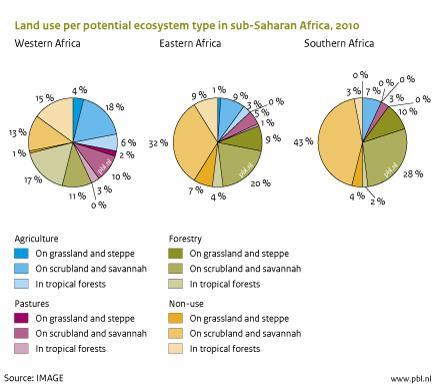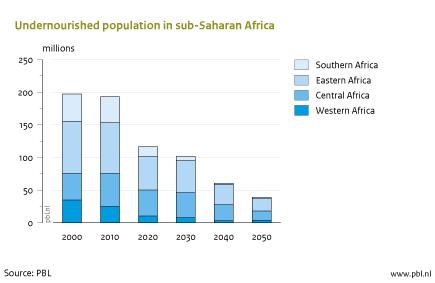Food security in sub-Saharan Africa: An explorative study
The agricultural production potential of sub-Saharan Africa would be sufficient to make the region food secure. Concerted and region-specific policies are needed to conserve and enhance the natural resource base of soil and nutrients, to make economic growth more beneficial for the poorest populations, and to eradicate the worst cases of malnutrition and food insecurity. In an exploratory study, PBL has analysed environmental and socio-economic trends and identified feasible policy directions at national and international levels.
Demand for food will increase with 300% in sub-Saharan Africa
Over the last decades, in sub-Saharan Africa, the number of undernourished people has increased by 41%, from 169 million around 1990 to 239 million in 2010. Population and income growth result in a more than fourfold increase in total food demand by 2050, compared to 2000, which is a much stronger increase than in other regions of the world. In 2050, the sub-Saharan African population is projected to more than double to 1.7 billion people by 2050 compared to 814 million in 2010. The resulting increase in food demand will be further enforced by the projected annual economic growth of more than 5% over the 2010–2050 period.

Sub-Saharan Africa has the potential to expand food production
Especially in west Africa, the potential for agricultural expansion is high, while in east Africa, where this potential is smaller, increases in production would rely on improved agricultural productivity.

Eradication of malnutrition by 2015 requires more effort
Malnutrition is expected to be eradicated almost entirely by 2050. However, the projected progress will not be enough to achieve the MDG target to reduce the level of malnutrition to 50% of the 1990 level, by 2015.

Increased agricultural production will be at the cost of the environment
The increase in agricultural production is expected to result in a reduction in forest cover of 29% and, consequently, an accelerated biodiversity loss up to 2030. Sub-Saharan Africa is expected to show an acceleration in species loss over the coming decades.

Important conditions to take into account to achieve food security
The most important conditions are:
- a healthy and educated population
- inclusive growth beneficial for the poor
- modernisation of agriculture
- balancing competing claims for energy, land and water
- institutional set-up that stimulates investments in agriculture
- environmental sustainability
- political stability and conflict resolution
In the arid regions food insecurity is due to lack of food
Improvement of the lives of populations in arid regions requires efforts to increase food production through conservation and restoration of the natural environment. The vulnerable people living in the arid areas in sub-Saharan Africa represent a relatively small share of the population. Recent promising initiatives to re-green the Sahel need to be systematically integrated in national policies, in such a way that the entire Sahel region will benefit. In addition, food programmes should incorporate a strategy for the structural alleviation of hunger.
In more productive regions access to food is limited for many people
In the more productive areas, higher economic growth is observed and population density is an important factor that determines the opportunities to improve access to food. A larger proportion of the population in these regions is more food secure, yet due to high population densities, many people still face malnutrition. Food security policies in more productive regions should focus on inclusive growth; for example, through making agricultural commodity chains more sustainable.
Recommendations for food security research and policy
Further research and policy work is needed to obtain better information on social and environmental indicators and to resolve the paradox of a resource-rich yet food insecure region. Key factors of food security are production enhancement, market development, social security policies, and national and regional governance efficiency.
More information
- OECD Environmental Outlook to 2050
- A global public-goods perspective on the environment and poverty reduction: Implications for Dutch foreign policy
- Scarcity in a Sea of Plenty? Global Resource Scarcities and Policies in the European Union and the Netherlands
- Other roles for governments needed in sustainable supply chain management?
Authors
Specifications
- Publication title
- Food security in sub-Saharan Africa: An explorative study
- Publication date
- 2 July 2012
- Publication type
- Publication
- Publication language
- English
- Product number
- 273




